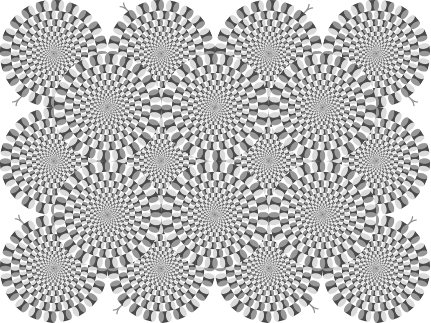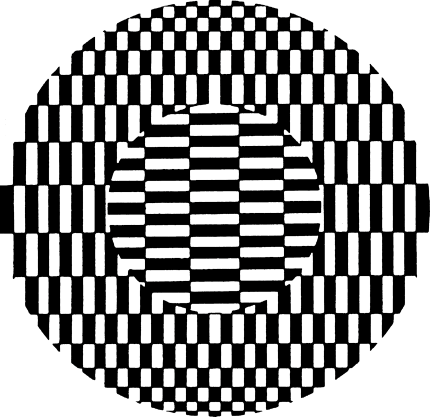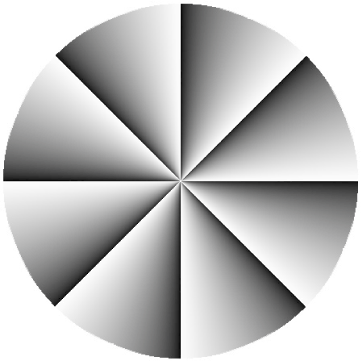Hack30.Understand the Rotating Snakes Illusion
|
Hack 30. Understand the Rotating Snakes Illusion
Shading in pictures combined with the continuous random jiggling our eyes make can generate compelling movement illusions. We've all seen optical illusions in which parts of a completely static picture appear to drift and swirl. One of the most famous examples is Professor Akiyoshi Kitaoka's rotating snake illusion (Figure 2-25), commonly passed around via email, but, sadly, rarely with explanation. Figure 2-25. The rotating snake illusion, Akiyoshi Kitaoka © 2003, is available in color at http://www.ritsumei.ac.jp/~akitaoka/index-e.html This is really a story about why you don't see everything moving all the time rather than about why you see movement sometimes when it isn't there. Your eyes constantly move in your head [Hack #15], your head moves on your body, and your body moves about space. Your brain has to work hard to disentangle those movements in incoming visual information that are due to your movement and those due to real movement in the world.
Another source of confusion for our visual system is a constant random drift in the exact focus of our eyes.1 This happens between saccades (see Figure 2-5, for example, in [Hack #15] ). Our muscles are constantly sending little corrective signals to keep our eyes in the same place. These signals never keep the eyes exactly still, producing so-called fixational movements. This is a good thing. If visual input is completely constant (i.e., if your eyes become paralyzed), the neurons in the eye stop responding to the constant input (because that is what they do [Hack #26] ) and everything fades out. Normally your brain uses the structure of the current scene combined with the assumption that small random movements are due to eye movement so as not to get distracted by these slight constant drifts. To actually see these fixational movements, you have to look at something without any structure and without any surrounding frame of reference. 2.19.1. In ActionWe need to get a handle on various principles of vision and motion computation before we can understand the rotating snakes illusion. Fortunately, each step comes with a practical demonstration of the principle. 2.19.1.1 The autokinetic effectYou will need a small point of light. A lit cigarette in an ashtray is idealslow-burning, small, and dim enough not to illuminate anything else near it. Place it at the other end of a completely darkened room so that all you can see is the light, not the table it is sitting on or the wall it is in front of. Stand back at the other end of the room from the light and watch it. You'll see it start to move of its own accord. This movement is due to the random drift of your eyes, which can't be compensated for by your brain because it has no frame of reference. You can get the same effect by looking at a single star through a tube. Without the other stars visible as a reference, it can look as if the single star is dancing slightly in the night sky. This autokinetic effect is famous for being influenced by suggestion. If you're introducing this effect to someone else, see if you can make him see the kind of motion you want by saying something like, "Look, it's going round in circles" or "Hey, it's swinging back and forth." 2.19.1.2 Ouchi illusionSo while we normally have these jiggly eye movements going on all the time, we use the structure of what we're seeing to discount them. But certain visual structures can co-opt these small random movements to create illusions of movement in static pictures. The rotating snakes illusion is one, but to understand the principle, it's easier to start with an older visual illusion called the Ouchi illusion, shown in Figure 2-26.2 Figure 2-26. The Ouchi illusionthe central circle appears to float above the other part of the design Here the central disk of vertical bars appears to move separately from the rest of the pattern, floating above the background of horizontal bars. You can increase the effect by jiggling the book. Your fixational eye movements affect the two parts of the pattern in different ways. The dominant direction of the bars, either horizontal or vertical, means that only one component of the random movements stands out. For the "background" of horizontal bars, this means that the horizontal component of the movements is eliminated, while for the "foreground" disk the vertical component of the movements is eliminated. Because the fixational movements are random, the horizontal and vertical movements are independent. This means that the two parts of the pattern appear to move independently, and your visual system interprets this as meaning that there are two different objects, one in front of the other. 2.19.1.3 Peripheral driftThe rotating snakes illusion (Figure 2-25) uses a different kind of structure to co-opt these small random eye movements, one that relies on differential brightness in parts of the pattern (color isn't essential to the effect3). To understand how changes in the brightness of the pattern create an illusion of motion in the periphery, see Figure 2-27. Figure 2-27. The peripheral drift illusion, in which the spokes appear to rotate in the corner of your eye4 In this simple pattern, the difference in the shading of the figure creates the impression of illusory movement. It makes use of the same principles as the rotating snakes, but it's easier to work out what's happening. Brighter things are processed faster in the visual system (due to the stronger response they provoke in neurons [Hack #11] ), so where the spokes meet, as one fades out into white and meets the black edge of another, the white side of the edge is processed faster that the black edge. The difference in arrival times is interpreted as a movement but only in the peripheral vision where your resolution is low enough to be fooled. The illusion of motion occurs only when the information first hits the eye, so you need to "reset" by blinking or quickly shifting your eyes. It works really well with two patterns next to each other, because your eye flicks between the two as the illusory motion in the periphery grabs your attention. Try viewing two copies of this illusion at the same time; open http://viperlib.york.ac.uk/Pimages/Lightness-Brightness/Shading/8cycles.DtoL.CW.jpg in two browser windows on opposite sides of your desktop. 2.19.2. How It WorksYou are now equipped to understand why Professor Kitaoka's rotating snakes illusion (Figure 2-25) works. Because the shape has lots of repeating parts, it is hard for your visual system to lock on to any part of the pattern to get a frame of reference. The shading of the different parts of the squares creates illusory motion that combines with motion from small eye movements that are happening constantly. The effect is greatest in your peripheral vision, where your visual resolution is most susceptible to the illusionary motion cue in the shading of the patterns. Your eyes are attracted by the illusory motion, so they flit around the picture and the movement appears everywhere apart from where you are directly looking. The constant moving of your eyes results in a kind of reset, which triggers a new interpretation of the pattern and new illusory motions and prevents you from using consistency of position across time to figure out that the motion is illusory. 2.19.3. In Real LifeProfessor Kitaoka's web page (http://www.ritsumei.ac.jp/~akitaoka/index-e.html) contains many more examples of this kind of anomalous motion and his scientific papers in which he explores the mechanisms behind them. We are constantly using the complex structure of the world to work out what is really moving and to discount movements of our eyes, heads, and bodies. These effects show just how artificial patterns have to be to fool our visual system. Patterns like this are extremely unlikely without human intervention. Professor Kitaoka has spotted one example of anomalous motion similar to his rotating snakes illusion that may not have been intentional. The logo of the Society For Neuroscience, used online (http://web.sfn.org), appears to drift left and right in the corner of their web site! Now you know what to look for, maybe you will see others yourself. 2.19.4. End Notes
|
|
EAN: N/A
Pages: 159